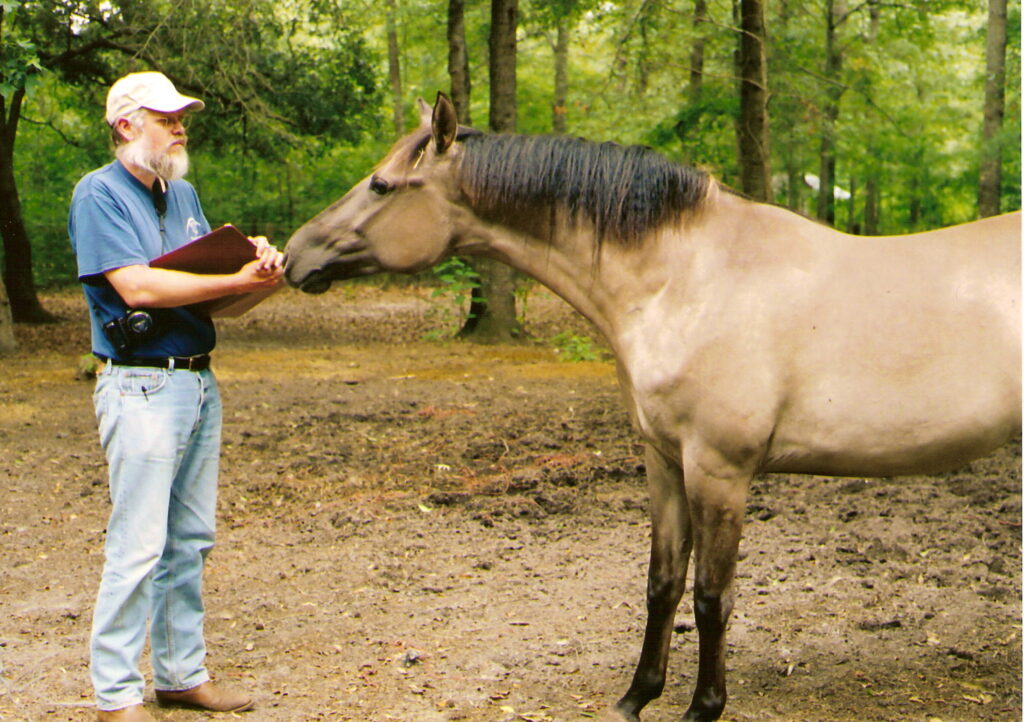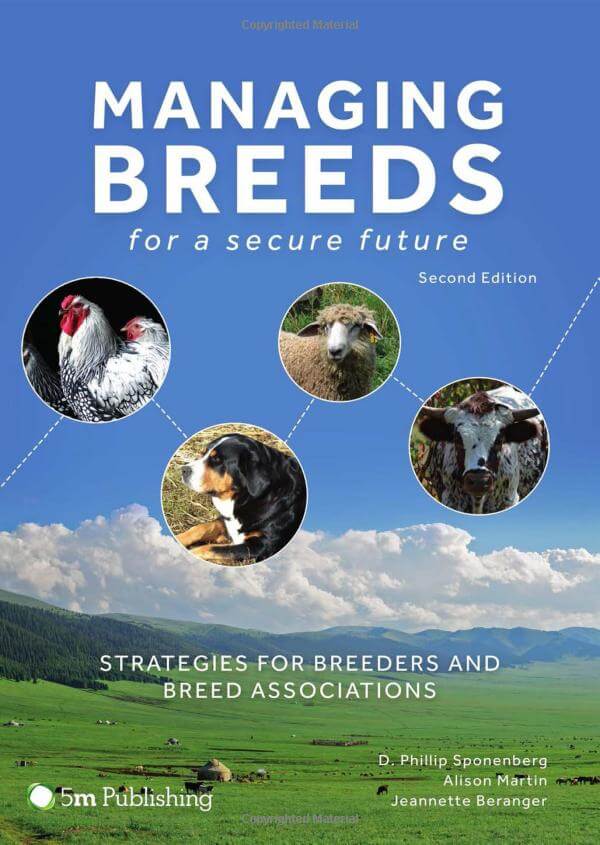Conservation Genetics

Dr. Phillip Sponenberg is pictured above conducting a field investigation of the Marsh Tacky horse
Why Conserving Genetics Matters
Conserving livestock and poultry genetic biodiversity is at the core of everything we do at The Livestock Conservancy. By conserving heritage breeds, we protect a diverse array of genetic traits that offer a safety net for our agricultural future. Traits found in various heritage breeds, like resistance to parasites or heat tolerance, offer a source of resilience for our food systems in the face of threats we cannot predict, like disease outbreaks or changing environmental conditions.
“Livestock play diverse biological roles. These must be better understood and utilized to conserve livestock biodiversity for a sustainable agricultural future. Many native and local breeds are important reservoirs of this genetic diversity,” said Dr. Phillip Sponenberg, DVM, PhD. “Identifying and conserving these breeds will be key to the development of sustainable agricultural systems that can persist amid the challenges of a changing climate and a rapidly growing human population.”
How Do We Conserve Genetics?
- We collect and track census data for rare livestock and poultry breeds
- We publish an annual Conservation Priority List
- We provide conservation breeding recommendations to breed stewards to help them maintain genetic diversity
- We publish numerous educational resources, such as Managing Breeds for a Secure Future, to help breeders and breed associations conserve genetic diversity
- We conduct herdbook and DNA studies to monitor breed diversity
- We help identify and rescue threatened populations through research and collaborative field work
- We bank rare genetics with our partners at the USDA’s National Animal Germplasm Program (NAGP)
Conservation Priority List & Census
Each year, The Livestock Conservancy publishes its Conservation Priority List of endangered breeds. The breeds on the list are classified into four categories that indicate their level of endangerment, from the rarest breeds in the “Critical” category to the more secure breeds in the “Recovering” category. The Conservation Priority List is based on the breed population numbers we collect year-round from national and international breed registries, individual breeders, hatcheries and breed associations.
Securing Rare Breeds through Genetic Analysis
The goal of genetic analysis is to understand the diversity within a breed and allows us to monitor trends over time. This work helps create a roadmap for conservation breeding and guides the work of breeders and breed organizations in preventing the genetic erosion of a breed.
Using pedigree and DNA information, the first step is to figure out the genetic structure of the breed population. For instance, how many males and females are there? What are their ages? How much is each herd or flock related to the others? How much are individual animals within the breed related to each other? All of this information gives breeders targets for maintaining diversity in their breeding programs.
Loss of genetic diversity can have serious consequences. Without variation in genes, a population can become less adaptable to new conditions or to improvement by selective breeding. Genetic diseases are more likely to appear. Loss of diversity can also result in animals having fewer offspring that survive to reproduce, and once gone, many breeds will be lost forever.
Gene Banking Biodiversity
Frozen samples of semen and tissues preserved decades ago can be used to re-create populations or to inject diversity into a breed from which it has been lost. A gene bank acts as a sort of “safe deposit box” for securing the unique genetic traits of our nation’s diverse breeds. Gene banking offers the ability to save the unique genes that make a breed heat-tolerant, hardy in low-input farming or successful in unique growing environments. Gene banks can hold thousands or even millions of samples, ensuring that valuable genetics are available when needed.
The Livestock Conservancy first established its own gene bank for rare breeds in 1986. Most of The Livestock Conservancy’s collection is now maintained by the USDA’s National Animal Germplasm Program (NAGP) and includes more than 4,100 samples from 19 rare breeds of cattle, pigs, sheep, goats and poultry. Occasionally, semen or other materials are withdrawn from the gene bank for special matings that restore or enhance breed diversity. In general, though, the samples are banked for the long term protection of unique genes.
Dr. Harvey Blackburn coordinates the work of the national gene bank. “The USDA’s National Animal Germplasm Program (NAGP) is a way to backstop the genetics of the livestock industries in the United States. We know that selection sometimes proceeds too heavily toward one trait, and that may lead to problems. Breeders may need to go back and regenerate a line or breed that existed in the past as a way to reintroduce genetic variation, or to pick a specific gene from a rare breed.” A close partnership between The Livestock Conservancy and the NAGP has been successful in protecting many rare breeds, but many more remain to be banked.
Conservation Breeding Strategies
Conservation breeding strategies specifically target the maintenance of all of the available genetic diversity with a breed, bloodline, flock, or herd. This type of breeding focuses on animals as a group, rather than on individuals. Attention is placed upon a breed, or on a herd or flock of a breed, to manage diversity through particular mating schemes and management techniques
Without a conservation breeding plan, the loss of genetic diversity can happen very rapidly, and with serious consequences. As variation decreases, a population can become less able to respond to a changing environment or to the needs of our human population. Loss of diversity can result in animals having fewer offspring that survive to reproduce, and breeds that were developed for hundreds or thousands of years can rapidly go extinct.
Conservation-focused breeding strategies can to help breed stewards achieve long-term success in their own breeding programs. The work of conservation breeding rests largely on the individual farmers and breeders of the animals, but its ultimate success depends on communities of breeders who work together to achieve this goal. When many people participate, the breed is held in multiple locations, which offers a backup in the event that a herd or flock is lost to disease or predation. A network of multiple herds, each independently managed and selected, is the best way to assure that conservation is successful. Cooperation among breeders is crucial to this success.
Resources for Conservation Breeding
The Livestock Conservancy serves as a resource for individuals and organizations who want to conserve rare breeds. The Livestock Conservancy researches and monitors the status of hundreds of breeds to determine conservation priorities, and the action steps needed, to save rare breeds. We work with longtime breeders, new farmers, conservation-minded individuals and many partners to save endangered breeds. Together, we educate breeders, the public and policy makers about the importance of these genetics through our outreach, publications and research.
If you are looking for information or resources to conserve rare heritage breeds, we offer many materials and programs to support your work:
- Breed-specific information, like our “Pick-a-Breed” charts
- Listings of breeders, products, breeding stock, and breed organizations
- Publications on conservation breeding, genetics and more specialized topics
- Microgrant Program for heritage breed farmers and breed organizations
- Cultivating Leadership Initiative for breed organizations and associations, including a breed organization training series
- Pedigree Registration Services
- Technical advice and support from our staff
Look over Our Projects page for examples of The Livestock Conservancy’s genetic conservation activities.


